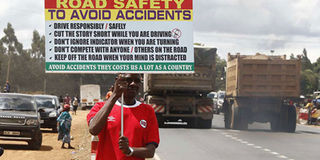Kenya seeks help to attain road safety goals

Charles Muchoki promotes road safety awareness at Sachangwan, Nakuru County, on November 18, 2018. PHOTO | FILE | NATION MEDIA GROUP
What you need to know:
- Though the government has signed up to a number of key initiatives aimed at reducing drivers' recklessness, the regulations are rarely enforced.
- Almost all countries in sub-Saharan Africa (except Liberia and Tanzania) have nominated a lead agency for road safety, according to the WHO.
The World Bank has included Kenya in its Africa-wide road safety initiative, which is aimed at curbing annual fatalities due to its high rate of traffic accidents.
The institution is funding the Global Road Safety Facility (GRSF), an initiative meant to support various transport agencies in Africa to establish strong-mandated and well-resourced government lead agencies to tackle road crashes.
The GRSF was established in 2006 to address the growing crisis of road traffic deaths and injuries in low- and middle-income countries.
Up to 13,000 people die each year on Kenyan roads. The country’s road traffic injury rate is among the highest in the world, although exact figures for road safety statistics are hard to obtain.
This is because, if only police data was used, the country’s roads would rank as some of the safest in the world at only 7.7 per100,000 people.
REGULATIONS
But according to World Health Organisation (WHO) estimates, Kenya’s road death rate stands at over 30 per 100,000 people. If accurate, this would place Kenya among the world’s 20 most notorious countries for road deaths.
The number of deaths are highest among pedestrians but are also particularly high among motorcycle users, a majority of whom do not wear helmets, according to research.
Another key reason for the high level of accidents is said to be Kenya’s blood alcohol limit of 0.08g alcohol per decilitre of blood, which is higher than the international guideline of 0.05.
Moreover, though the government has signed up to a number of key initiatives aimed at reducing speed on the road, tackling drivers who drink and drive and improving vehicle safety, the regulations are rarely enforced.
CRISIS
This comes as a new WHO report — Global status report on road safety 2018 — shows that road traffic accidents (RTA) are now the leading causes of young people's death in Africa.
Ten percent of all deaths in Kenya are related to preventable injuries, the leading causes of which are RTA’s. The new WHO report says Africa is witnessing a road safety crisis.
“With the highest per capita rate of road fatalities in the world, road deaths in sub-Saharan Africa are projected to more than double from some 243,000 deaths projected for 2015 to 514,000 by 2030,” the report says.
CAUTION
Almost all countries in sub-Saharan Africa (except Liberia and Tanzania) have nominated a lead agency for road safety, according to the WHO.
These agencies however may not have a strong government mandate or sufficient funding. Some may be government institutions with low levels of safety management capacity.
The WHO report reveals that only one percent of all the vehicles in the world are in poor countries, yet 13 percent of all vehicle-related deaths occur there.
High-income nations account for 40 percent of the world’s cars, and only seven percent of total traffic fatalities.





